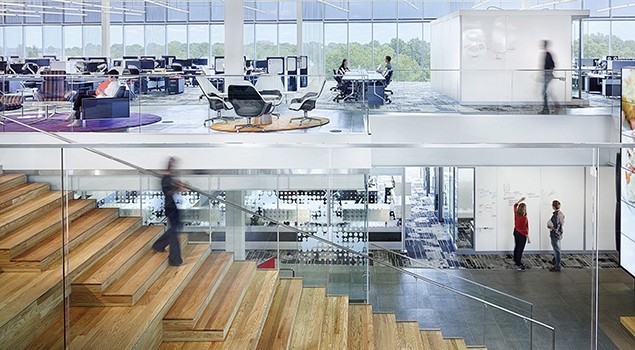by Brianna Crandall — October 26, 2016 — Global design, architecture, engineering and planning firm HOK’s WorkPlace practice, in partnership with the U.K. chapter of corporate real estate (CRE) association CoreNet Global, has just released a new report that studies the impact of coworking from a corporate real estate (CRE) perspective.
Coworking is one of the fastest-growing sectors of the CRE market, points out HOK. The new report, Coworking: A Corporate Real Estate Perspective, examines the drivers of coworking from the demand and supply sides; the industry risks and implications for corporate real estate; and information about the owners, coworkers and centers.

The report examines the drivers of coworking from the demand and supply sides; the industry risks and implications for corporate real estate; and information about the owners, coworkers and centers.
The HOK/CoreNet Global Coworking report highlights the ideas that changing business priorities and the need to attract talented people, reduce real estate costs, improve speed to innovation, and increase productivity are driving corporations to consider different workplace models, including on- and off-site coworking.
Kay Sargent, ASID, IIDA, CID, LEED AP, MCR.w, director of WorkPlace at HOK, stated:
Although coworking space makes up less than one percent of the world’s office space, it represents an important workforce trend and highlights the strong desire of today’s employees to have workplace choices, community and flexibility. Driven by demand factors, including next-generation work styles and the desire for real estate portfolio agility, C-suite executives from human resources, operations, real estate and finance are increasingly interested in how coworking affects their work practices and policies — and how they need to design, manage and operate their workplaces.
Other key findings from the Coworking report include:
- The coworking concept is evolving to comprise accelerators, incubators and maker spaces. It reaches beyond office settings to include college campuses, retail locations, hotels and libraries.
- The impact of coworking spaces on CRE includes providing new uses for older properties and for underutilized spaces in existing facilities.
- The lowest engagement levels are found in employees who never work remotely. The highest employee engagement levels occur among those who work remotely less than 20% of the time.
- Many coworking centers emerged in a time of high unemployment and low rents. But 54% of the coworkers will leave a specific location in less than a year. The high turnover and tenant instability challenge coworking centers to maintain profitability. They are vulnerable to market conditions and new competitors.
Curtis Knapp, director of consulting for HOK, commented:
For corporate occupiers and other real estate professionals, the coworking trend is worth watching, exploring and testing. It is a way to add flexibility to the portfolio and help match the ebb and flow of supply and demand. It can be one solution to the many challenges posed by the changing nature of both work and worker.
Philip Cohen, president of CoreNet Global’s U.K. chapter, added:
Our workplace community is a highly interactive forum where ideas, research and results are developed and shared. Our aim is to demonstrate how the workplace can influence major business issues and equip members with the knowledge to bring about change.
The HOK/CoreNet Global Coworking: A Corporate Real Estate Perspective report is available to download upon brief registration on the HOK Web site.




